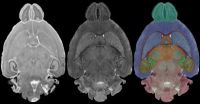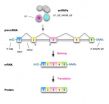Chemotherapy plus radiation prevents bladder cancer recurrences
Treatment offers patients an alternative to surgery
2010-10-26
(Press-News.org) Adding chemotherapy to radiation therapy for muscle invasive bladder cancer allows 67 percent of people to be free of disease in their bladders two years after treatment. This compares to 54 percent of people who receive radiation alone, according to the largest randomized study of its kind presented at the plenary session, November 1, 2010, at the 52nd Annual Meeting of the American Society for Radiation Oncology (ASTRO).
"The trial shows that this treatment offers improved control of cancer within the bladder with acceptable long-term side effects and is therefore a viable alternative to radical surgery in patients with muscle invasive bladder cancer," said Nicholas James, M.D., an oncologist at University of Birmingham in Birmingham, England, United Kingdom, who jointly led the study with Robert Huddart, M.D., from the Institute of Cancer Research in the United Kingdom. "This may shift the balance from surgery to chemo-radiotherapy as the primary treatment for many patients with invasive bladder cancer."
Bladder cancer affects about 70,000 Americans each year. It is four times more common in men than in women and two times more common in Caucasians than African-Americans. Cure rates for advanced bladder cancer are generally poor, with only around 40 percent of those with this form of the disease living more than five years after diagnosis.
In the United States, the most common treatment for advanced bladder cancer is complete removal of the bladder, which compromises patients' normal urinary function. Radiotherapy has been used as an alternative for some time. Doctors have been making advances in combining radiation therapy and chemotherapy as a way to treat bladder cancer while allowing patients an opportunity to maintain normal bladder function.
This multicenter randomized trial, conducted at 45 institutions in the United Kingdom, examined whether adding chemotherapy to radiation treatment is safe and more effective than giving radiation alone in preventing bladder cancer from returning. The trial also compared two ways of giving radiation therapy.
From August 2001 to April 2008, 458 invasive bladder cancer patients entered the trial. Results of the study show that the combination of chemotherapy and radiation treatment reduced the long-term risk of recurrence of cancer within the bladder, while also preserving bladder function.
###
This work was supported by Cancer Research U.K. (CRUK/01/004). The trial was coordinated by the Cancer Research U.K. Clinical Trials Unit at the University of Birmingham and the Cancer Research U.K. funded Clinical Trials and Statistics Unit at the Institute of Cancer Research (ICR-CTSU) with statistical support led by Emma Hall, Ph.D., deputy director (Research), ICR.
For more information on radiation therapy for bladder cancer, visit www.rtanswers.org/treatmentinformation/cancertypes/bladder.
The abstract, "Results of a 2x2 Phase III Randomized Trial of Synchronous Chemo-radiotherapy (CRT) Compared to Radiotherapy (RT) Alone and Standard Versus Reduced High Volume RT in Muscle Invasive Bladder Cancer (MIBC) (BC2001 CRUK/01/004)" will be presented at the plenary session at 2:30 p.m. on Monday, November 1, 2010. To speak to the lead author of the study, Nicholas James, M.D., please call Beth Bukata or Nicole Napoli on October 31 - November 2, 2010, in the ASTRO Press Room at the San Diego Convention Center at 619-525-6313 or 619-525-6314. You may also e-mail them at bethb@astro.org or nicolen@astro.org.
END
ELSE PRESS RELEASES FROM THIS DATE:
2010-10-26
Stereotactic radiation is an effective, long-term treatment for trigeminal neuralgia: a painful condition that occurs with increased frequency in patients with multiple sclerosis (MS). Radiation is noninvasive and has less negative side effects than other treatments, according to the longest follow-up in a study of its kind presented October 31, 2010, at the 52nd Annual Meeting of the American Society for Radiation Oncology (ASTRO).
Multiple sclerosis is a progressive neurological disease affecting about 300,000 Americans where the body's immune system attacks its own ...
2010-10-26
Laxenburg, Austria – 26th October 2010 --
A new assessment of future scenarios that limit the extent of global warming cautions that unless current imbalances in R&D portfolios for the development of new, efficient, and clean energy technologies are redressed, greenhouse gas (GHG) emission reduction targets are unlikely to be met, or met only at considerable costs.
The study identifies energy efficiency as the single most important option for achieving significant and long-term reductions in GHG emissions, accounting for up to 50 percent of the reduction potential across ...
2010-10-26
ITHACA, N.Y. – The human hand is an amazing machine that can pick up, move and place objects easily, but for a robot, this "gripping" mechanism is a vexing challenge. Opting for simple elegance, researchers from Cornell University, University of Chicago and iRobot have bypassed traditional designs based around the human hand and fingers, and created a versatile gripper using everyday ground coffee and a latex party balloon.
They call it a universal gripper, as it conforms to the object it's grabbing rather than being designed for particular objects, said Hod Lipson, ...
2010-10-26
In scientific publishing, how much reuse of text is too much? Researchers at the Virginia Bioinformatics Institute at Virginia Tech and collaborators have shown that a computer-based text-searching tool is capable of unearthing questionable publication practices from thousands of full-text papers in the biomedical literature.
The first step in the process is to find out what is restated before zeroing in on who may have crossed an ethically unacceptable threshold. The findings, published in PLoS ONE, offer hope for curbing unethical scientific publication practice, ...
2010-10-26
VIDEO:
This video contains more on the pediatric bone cancer preclinical study.
Click here for more information.
BOSTON - Researchers have identified an important signaling pathway that, when blocked, significantly decreases the spread of pediatric bone cancer.
In their study, researchers at The University of Texas MD Anderson Children's Cancer Hospital in Houston found that blocking the Notch pathway in mice decreased metastases in the lungs 15-fold. The results of ...
2010-10-26
DURHAM, N.C. – The most detailed magnetic resonance images ever obtained of a mammalian brain are now available to researchers in a free, online atlas of an ultra-high-resolution mouse brain, thanks to work at the Duke Center for In Vivo Microscopy.
In a typical clinical MRI scan, each pixel in the image represents a cube of tissue, called a voxel, which is typically 1x1x3 millimeters. "The atlas images, however, are more than 300,000 times higher resolution than an MRI scan, with voxels that are 20 micrometers on a side," said G. Allan Johnson, Ph.D., who heads the ...
2010-10-26
PHILADELPHIA - When most genes are transcribed, the nascent RNAs they produce are not quite ready to be translated into proteins - they have to be processed first. One of those processes is called splicing, a mechanism by which non-coding gene sequences are removed and the remaining protein-coding sequences are joined together to form a final, mature messenger RNA (mRNA), which contains the recipe for making a protein.
For years, researchers have understood the roles played by the molecular machines that carry out the splicing process. But, as it turns out, one of those ...
2010-10-26
Even if a woman is perfectly clear in expressing sexual interest or rejection, young men vary in their ability to remember the cues, a new University of Iowa study shows.
Overall, college-age men were quite good at recalling whether their female peers – in this case, represented through photos – showed interest. Their memories were especially sharp if the model happened to be good looking, dressed more provocatively, and conveyed interest through an inviting expression or posture.
But as researchers examined variations in sexual-cue recall, they found two noteworthy ...
2010-10-26
VIDEO:
Boston College DeLuca Professor of Biology Marc A.T. Muskavitch discusses his latest malaria research, published in the journal Science. Muskavitch and an international team of researchers developed the first high-resolution...
Click here for more information.
CHESTNUT HILL, Mass. (10/25/2010) – The development and first use of a high-density SNP array for the malaria vector mosquito have established 400,000 genetic markers capable of revealing new insights into how ...
2010-10-26
Thanks to a microwave oven, the fundamental nanotechnology process of self assembly may soon replace the lithographic processing use to make the ubiquitous semi-conductor chips. By using microwaves, researchers at Canada's National Institute for Nanotechnology (NINT) and the University of Alberta have dramatically decreased the cooking time for a specific molecular self-assembly process used to assemble block copolymers, and have now made it a viable alternative to the conventional lithography process for use in patterning semi-conductors. When the team of chemists and ...
LAST 30 PRESS RELEASES:
[Press-News.org] Chemotherapy plus radiation prevents bladder cancer recurrences
Treatment offers patients an alternative to surgery


